Drones are only as good as their power source. Yet with so many options available, it’s easy to get lost in technical trade-offs.
Most drones today rely on lithium batteries—but alternatives like hydrogen fuel cells and solar hybrids are quietly changing the game.
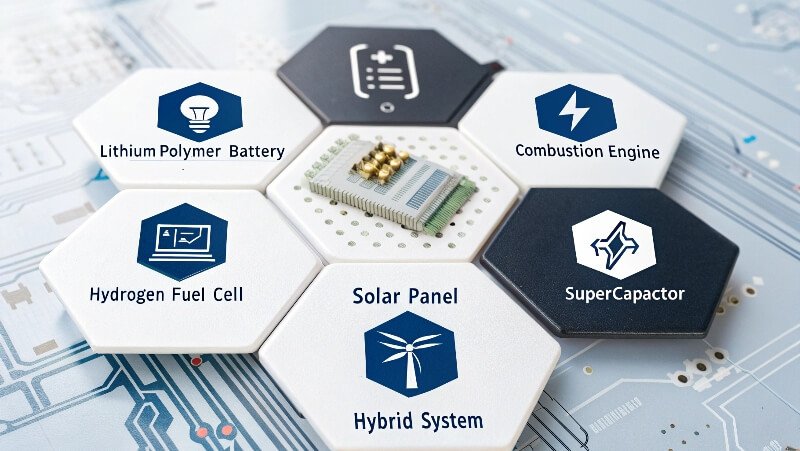
Which drone power source is right for your application? Let’s compare the six major contenders—from conventional batteries to futuristic hydrogen systems.
Lithium Polymer (LiPo) and Lithium-Ion Batteries
LiPo batteries are currently the go-to power source for most commercial and recreational drones. They offer high energy density, fast discharge rates, and relatively light weight, making them ideal for small to medium UAVs. Li-ion variants, while heavier, provide better energy storage and longer life cycles in some cases. Despite limitations like limited cycle life and fire risks, lithium batteries remain dominant due to their maturity and wide availability.
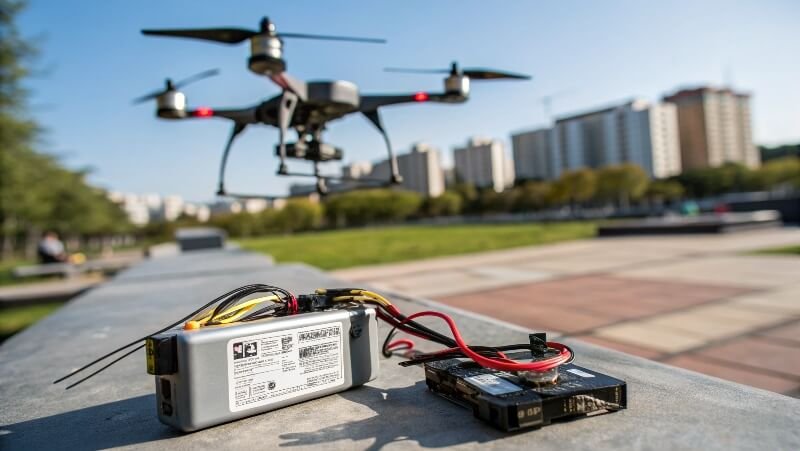
Combustion Engines
Combustion engines offer raw power and long endurance, but at the cost of noise, emissions, and maintenance complexity. These engines are used in certain fixed-wing UAVs and long-range applications where energy density outweighs environmental concerns. They run on gasoline or kerosene and can sustain multi-hour flights with heavy payloads. However, they are less favored in modern drone designs due to their mechanical complexity and environmental footprint.

Hydrogen Fuel Cells
Hydrogen fuel cells are emerging as a clean, high-endurance alternative to traditional batteries. These systems convert hydrogen into electricity through electrochemical reactions, emitting only water vapor. Their high energy density and fast refueling make them ideal for UAVs needing 2–6 hours of flight time. While cost and hydrogen supply are still challenges, fuel cells are gaining traction in research, industrial, and government drone sectors.
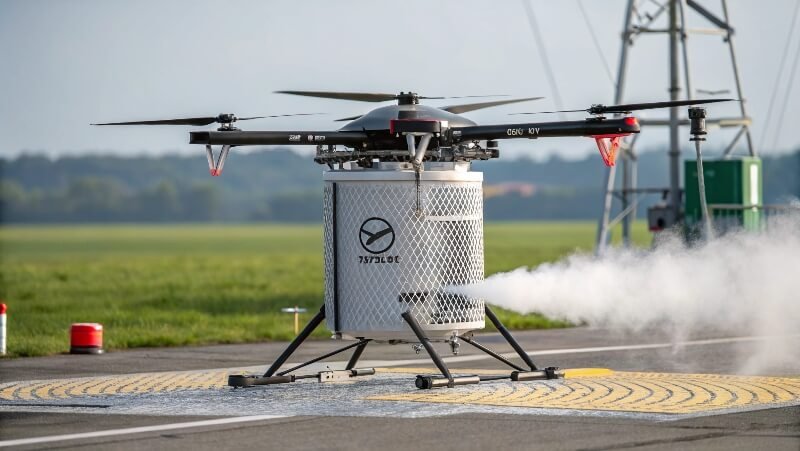
Solar Power and Solar-Battery Hybrids
Solar-powered drones use photovoltaic cells to harness the sun’s energy—typically in combination with battery systems. These setups offer the potential for ultra-long endurance, especially in fixed-wing or high-altitude drones. However, low power density and weather dependency limit their usefulness for multirotor platforms or cloudy regions. Solar-battery hybrids represent a promising area for extending flight times without emissions.

Supercapacitors (SCs)
Supercapacitors store and discharge energy rapidly, offering advantages in power spikes, quick bursts, or regenerative braking. However, their energy density is far lower than batteries, which limits their use to specialized roles. They’re often paired with batteries or fuel cells to provide hybrid performance, especially in VTOL systems or start-stop intensive operations.
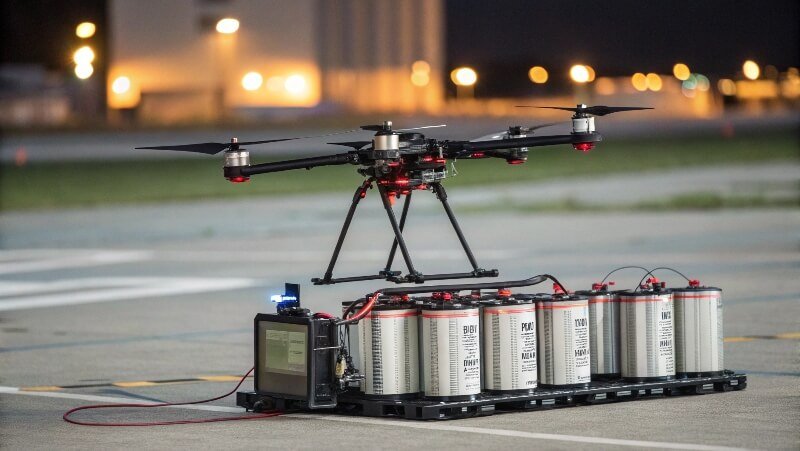
Hybrid Power Systems
Hybrid drone systems combine two or more power sources to balance endurance, efficiency, and performance. These include fuel cell–battery, engine–generator, or solar–battery combinations. By mixing high energy density (fuel cells or engines) with high power output (batteries or supercapacitors), hybrids can support longer missions with greater flexibility. Integration and system complexity are higher, but the performance gains often justify the effort.
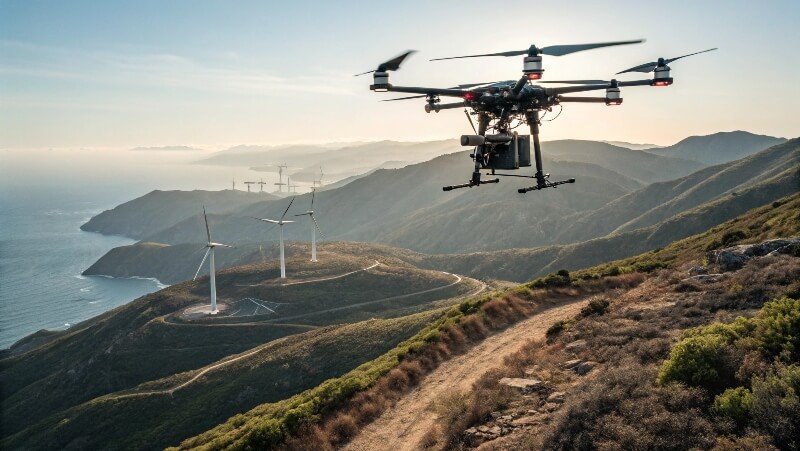
Why are lithium polymer batteries the preferred power source for drones?
Lithium polymer batteries dominate the drone market due to their efficiency, compactness, and affordability.
They offer high power-to-weight ratios and can be easily adapted to different drone sizes and missions. Most entry-level to professional UAVs use LiPo because of their predictable behavior, quick recharge, and cost-effectiveness.

The Strengths and Trade-offs of LiPo Technology
High burst output: LiPo cells handle sudden power draws well, critical for takeoffs and maneuvers.
Modular scaling: Batteries can be swapped or stacked to match mission needs.
Low upfront cost: Compared to hydrogen or combustion, LiPo packs are more budget-friendly.
| Feature | Lithium Polymer | Hydrogen Fuel Cell | Combustion Engine |
|---|---|---|---|
| Energy Density | Medium | High | High |
| Emissions | None | Water vapor | CO₂ + NOx |
| Flight Time | 20–45 mins | 1.5–6 hrs | 2–8 hrs |
| Maintenance | Low | Moderate | High |
However, LiPo batteries also degrade faster, pose fire hazards under misuse, and limit long-endurance missions. This is why alternative sources are being explored.
How does hydrogen fuel cell technology compare to traditional batteries in drone applications?
Hydrogen fuel cells offer longer flight times, lower emissions, and faster refueling than lithium batteries.
They outperform in scenarios where endurance, reliability, and sustainability matter more than initial cost or availability. As hydrogen infrastructure improves, more industries are making the shift.

Key Advantages of Hydrogen Fuel Cells
Higher energy density: Fuel cells pack more energy per unit mass, extending flight time significantly.
Quick refueling: Takes minutes, compared to hours of battery recharging.
Stable under heavy loads: Ideal for consistent power output during long-duration missions.
| Performance Metric | Hydrogen Fuel Cell | Lithium Battery |
|---|---|---|
| Typical Flight Time | 2–6 hrs | 20–45 mins |
| Refueling Time | 2–5 mins | 60–90 mins |
| Temperature Tolerance | Broad (-10°C to 50°C) | Moderate (0–40°C) |
| Cycle Life | 1,000–3,000 cycles | 300–500 cycles |
From drone logistics to academic UAV platforms, hydrogen is quickly becoming the next power standard. I’ve worked with clients whose drones saw up to 6x longer airtime after switching to hydrogen systems.
What are the environmental impacts of using battery versus fuel cell power sources?
Battery and fuel cell power both reduce emissions compared to combustion, but differ in their environmental footprints.
While Li-ion batteries produce no direct emissions, they have higher hidden costs in raw material extraction and disposal. Hydrogen fuel cells emit only water—but hydrogen production and transport must be clean to stay green.
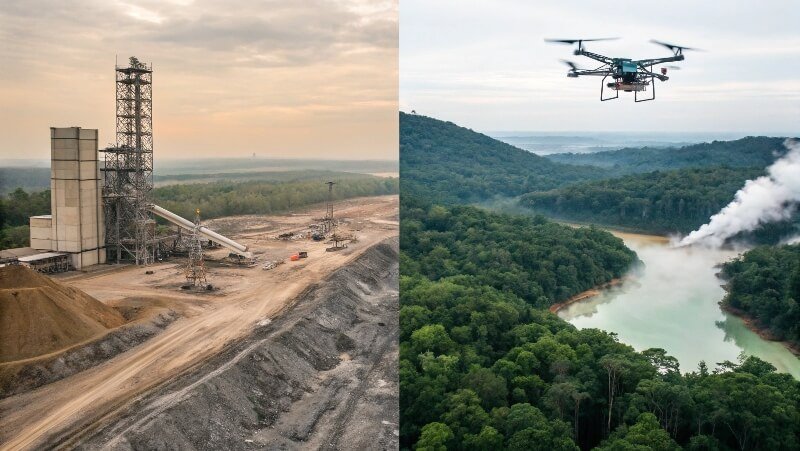
Life Cycle Environmental Impact
| Stage | Lithium Batteries | Hydrogen Fuel Cells |
|---|---|---|
| Resource Extraction | Lithium, cobalt mining | Water electrolysis / natural gas |
| Manufacturing | Energy-intensive | Moderate energy use |
| Operational Emission | Zero | Water vapor |
| End-of-Life | Recycling challenges | Easier component reuse |
In the long run, green hydrogen (from renewable sources) could surpass batteries in sustainability. But that depends on upstream emissions and the adoption of circular supply chains.
Conclusion: Powering the Future of Flight
As drone technology evolves, so do its power systems. While lithium polymer batteries currently dominate, hydrogen fuel cells are rapidly emerging as a clean, high-endurance alternative. Combustion engines and supercapacitors serve niche roles, while solar and hybrid solutions push the boundaries of endurance and sustainability.
No single power source fits all drone missions. The optimal choice depends on your priorities: endurance, payload, environmental impact, or cost. But one thing is clear—power innovation is unlocking new skies for drones across industries.
Frequently Asked Questions (FAQ)
Q1: What’s the average flight time of a LiPo-powered drone?
Most LiPo battery drones fly between 15–45 minutes, depending on payload and conditions.
Q2: Are hydrogen fuel cells safe for drones?
Yes, when engineered properly. They include multiple safety layers for pressure, temperature, and hydrogen leakage.
Q3: Can solar drones fly indefinitely?
Not quite—solar alone rarely meets power demands. But hybrid solar-battery systems can extend endurance significantly in sunny conditions.
Q4: Why don’t we see more combustion engine drones?
Noise, vibration, emissions, and maintenance issues limit their use to specific heavy-lift or legacy platforms.
Q5: Can supercapacitors replace batteries in drones?
No—they lack energy density but are excellent for short bursts of power. They’re best used in hybrid setups.



